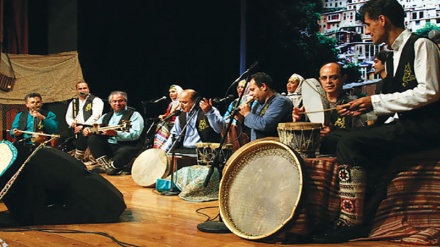Iran; Land of Various Ethnicities (8)
In continuation of discussing the traditions of Lor people, in this episode we will touch upon the Lori music and Bakhtiari music.
To get familiar with the music of Bakhtiari people one has to study the rhythms, melodies and the basis of their songs and music. It is out of the scope of this radio program to get into the technical details of Bakhtiari music; however, we will try to have a general look at the issue.
The Bakhtiari music and poetry are interconnected with life. The melodies of Bakhtiari music are called “Beit” and some of the famous ones include, “Galedari”, “Barzegari”, “Abol Qasem Khani” and “Shir Ali Mardun”. There are nearly 25 melodies in Bakhtiari music. Each clan and tribe has special local musicians which are called “Tushmal”. The musicians have separate clans and residences. They earn money through participating in wedding ceremonies, mourning ceremonies and other feasts and ceremonies and are engaged in agriculture and animal husbandry, too. During wedding ceremonies, these musicians (Tushmals) read the poems that have been composed by native poets. The topic of the poems revolves round the valour and prowess of some of the local heroes or romantic issues.
These poems contain interesting points which indicate the ideas and mentality of the people toward different issues.
The Bakhtiari musicians (Tushmals) are also invited for performing at the time of harvest. These musicians have poetic tendencies with romantic characteristics. They spend most of their time on versifying, making jokes, proverbs and parables. They play a major role in the enrichment of Bakhtiari culture and literature. A group of them leads an itinerant life and migrate from one place to another in summer or winter. The Bakhtiari musicians are very indefatigable in playing musical instruments and can play various melodies incessantly for hours. The musical instruments of Bakhtiari people are simple and mainly include Saaz, Dohol and Korna. In this part of the program we invite you to listen to a piece of music performed by Tushmals.
One of the famous and popular customs of Bakhtiari people is called “Chub Bazi” which is performed by men during wedding ceremonies. A man takes a long wooden stick in his hand as the defender and another man takes a softer stick and attacks the defender with a Saaz in his hand.
The music of Lorestan (Lori music), also, dates back to old times and is divided in two main parts: song music and instrumental music. The archaeological excavations of the Lor-inhabited regions indicate that the Lori music dates back to the fourth millennium BC. Moreover, images have been found of musical instruments like trumpet and tanbur (a long-necked string instrument) indicating the prevalence of such instruments in the Sassanid era. Some of the ancient melodies have remained in the form of ethnic songs.
The Lori music is divided in the following categories: lyric music and songs, epic music and songs, elegiac music and songs, job music and songs, and religious music and songs. The musical instruments of Lor people include: Sorna (Persian oboe), Dohol (cylindrical drum), Taar (a stringed instrument), Kamancheh (the chief Persian bowed string instrument) and Tombak (cup-shape drum). However, Kamancheh of Lor people is the only instrument which is basically different from other forms of Kamancheh among other ethnicities in Iran or abroad.
To name the famous songs among Lor people, mention can be made of Qadam Kheir, Rangineh, Kafsh Tala, Sanam Gol and Halu Gandom. The epic music and songs of Lor people have functioned for two purposes, namely, encouraging the clans and tribes to go to the battlefield and keeping the memory of some heroic figures of Lor people. The famous Daya Daya song is a very popular epic and heroic song which used to be broadcast during the 8 year war imposed by the US through its puppet Saddam. The song was not only a famous song among Lor people it also gained nationwide popularity and was broadcast many times on the radio and TV during the days of the Sacred Defence.
RM/MG


